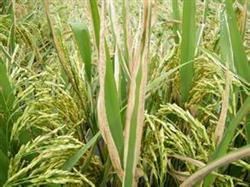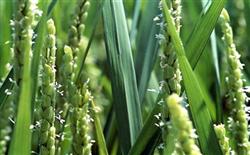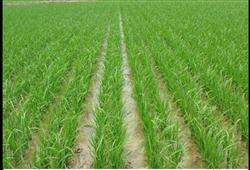Analysis on the causes of rice bacterial blight and its control techniques

The pathogen of rice bacterial blight is Xanthomonas oryzae, bacteria, Xanthomonas genus. Bacterial blight is one of the main diseases of rice. Once it occurs, the yield can be reduced by 10% in general and 50-60% in serious cases. Therefore, it is very important to strengthen the control of bacterial blight. 1. Causes of disease 1.1 The relationship between disease and climatic conditions High temperature, high humidity, strong wind and heavy rain are the climatic conditions for bacterial blight epidemic. The disease started at 17℃, peaked at 26-30℃, had a short incubation period, took only 3-5 days for the pathogen to invade and showed symptoms, and the number of reinfection increased. The disease did not occur at continuous low and high temperatures below 17℃ and above 35℃. The relative humidity was above 90%, which was beneficial for the pathogen to infect the host. 1.2 The relationship between disease incidence and disease resistance and growth period of rice varieties had some differences in resistance to bacterial blight. Generally, glutinous rice was the most resistant, japonica rice was more resistant than indica rice, tall stem and narrow leaf varieties were more resistant than short stem and broad leaf varieties, fertilizer tolerant varieties were more resistant than fertilizer tolerant varieties, varieties with less water holes in leaf surface were more resistant than varieties with more water holes in leaf surface, and susceptible varieties were more susceptible to epidemic disease. The same variety was more resistant from seedling stage to tillering stage, decreased in resistance at tillering stage, susceptible to disease at booting stage, and most susceptible at heading stage. 1.3 The relationship between disease occurrence and cultivation techniques: excessive, late and concentrated application of nitrogen fertilizer, especially improper application of panicle fertilizer, will weaken the disease resistance of plants, close rows between plants, poor ventilation and light transmission, thick green leaves and tender leaves. Flooded disease is more serious than unflooded disease. Field irrigation and flood irrigation can directly promote the spread of disease, but the rice plants soaked in deep water for a long time have a greater impact on the disease, which is mainly due to the high humidity in the field, which is conducive to the propagation and infection of pathogens. Deep irrigation can increase the accumulation of toxic substances in the soil, and promote the disease resistance of rice plants to decline. Deep irrigation after jointing is more serious. 2. Control technology 2.1 Select disease-free seeds. 2.2 Scientific field management should apply sufficient base fertilizer, early topdressing, clever application of ear fertilizer, no partial application of nitrogen fertilizer, balanced application of nitrogen, phosphorus, potassium and trace fertilizers. Strictly prevent flooding seedlings, cultivate high-quality strong seedlings, and advocate dry seedling cultivation. Field irrigation should be shallow water frequently, dry and wet alternately, dry and wet, timely and moderate sun field, the field has been affected should not be re-sun, so as not to aggravate the disease. 2.3 Timely control field application to achieve the principle of "one point to cure one piece, one piece to cure one piece", timely spray to block the disease center, if the weather is favorable for the disease, should implement the same kind of field survey control, so as to control the spread of diseases. In the areas where bacterial blight often occurs, Ye Kuning should be used for prevention at booting stage, and Ye Kuning 100g mixed with 60kg water should be sprayed evenly on each mu of flooded fields and fields hit by storm after water is dry and sunny. In the early stage of bacterial blight, generally every 5- 7 days, 100 grams of Ye Kuning mixed with 60 kilograms of water per mu is sprayed once for 2-3 consecutive times to reduce and reduce the loss caused by bacterial blight.
- Prev

Rice heading difficulty can be sprayed with gibberellin
It is difficult for rice to heading, or the phenomenon of neck wrapping appears. Because the rice grains wrapped in the leaf sheath can not be pollinated and fertilized in time, they will generally become empty grains, which has a great impact on the yield. There are many reasons for this phenomenon, some of which are more serious in terms of neck wrapping, especially in adverse environmental conditions.
- Next

What is the cause of Tillering death in Rice and Wheat
Q: I am from Sihong County. Here, many of the tillers of wheat do not grow and eventually shrink and die, and so does rice. In addition, there are several grains missing at the base of the wheat ear, or the branchlets at the base of the rice ear do not bear particles as if they had been rolled. What is the reason for this? Answer: a large number of tillers died in the middle and later period of wheat and rice growth.
Related
- The first cup of black tea in spring, the flavor and history of tea gardens in Kenya, Africa
- The computer can not only choose potatoes, but also grow tea rice. AI will grow winter oolong tea champion.
- It is not only the inflated tea bitten by insects, but also engraved with the four seasons tea in Beipu.
- The Oriental Beauty Tea Festival in Zhuxian County takes the stage at the weekend to experience the plus-size feast of oil tea.
- & quot; Oriental Beauty Tea & Exploration of Emei in Hsinchu, the hometown of quot;
- The new variety of strawberry "Tainong 1" dessert is the first choice with mellow aroma. Crimson gorgeous
- History of Tea in Taiwan: from Wild Inner Mountain to Export Tea Garden
- Two types of Taiwan Oriental Beauty Black Tea won the British three-Star Award for Childhood Tea Xiang Zhang Jiaqi changed from pilot to champion tea maker.
- Banana species and varieties: the planting history of Taiwan Xianren banana and dwarf banana is long, is banana disease resistant?
- Coffee planting Technology: Qianjie Coffee from Seedling to harvesting

